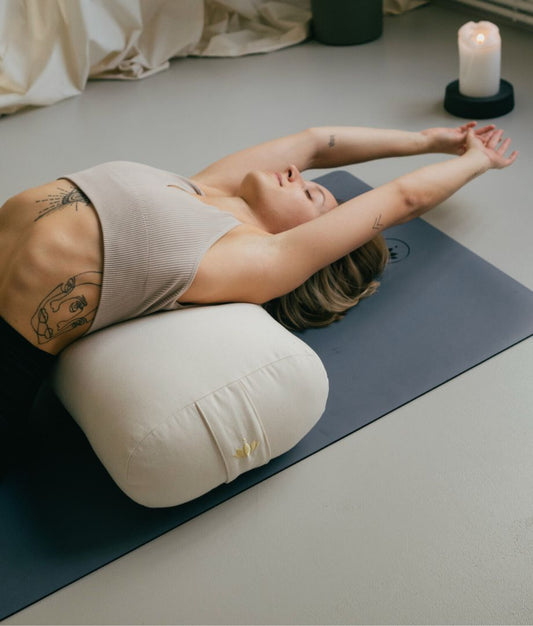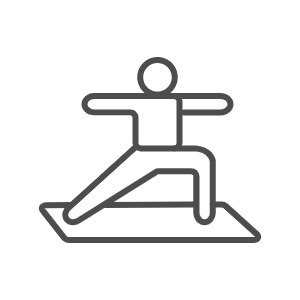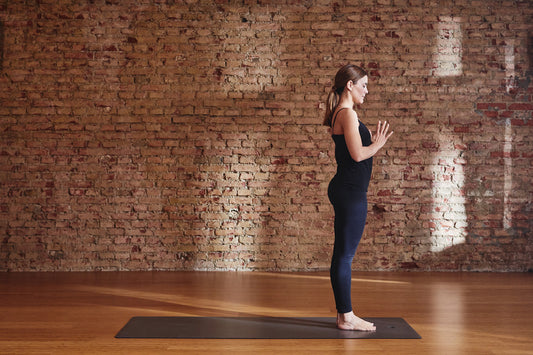
Set-Offers
Save when you buy a set
Shopping cart
Your shopping basket is empty
Yoga

Meditation
Bundles

| Yoga
Hardly any exercise sequence is as well known as the sun salutation. The activating sequence consists of several asanas that are fluently connected with each other. The sun salutation is often used as a warm-up exercise at the beginning of a yoga class, but is also ideal for getting your circulation going in the morning or for loosening up the body in between. We will show you step by step how to do the sun salutation correctly.
Surya Namaskara, as the sun salutation is called in Sanskrit, always consists of an upward-downward movement . Literally translated, Surya Namaskara means "Glory to you, sun" and the sun prayer is traditionally practiced every morning. There are different variations of the sun salutation, as well as an A and B variant. We introduce you to the sun salutation A.
Like all asanas, the sun salutation is also focused on breathing . Try to control your movements by inhaling and exhaling, because ultimately it's not about the exercise itself, it's about the flow of the breath.
At the beginning you stand firmly on both feet, the insides of your feet are close together. Your legs are active, your shoulders drop loose and relaxed . Your palms touch in front of your chest in Anjali Mudra. Breathe calmly and activate your belly. Take a few breaths until you can be fully aware of the exercise.

As you inhale, stretch your arms up, palms touching, your gaze following your hands. The sides of your body are long and you let the air flow deep inside you.

On an exhale, spread your arms out to your sides and , keeping your back straight, bend forward until your fingertips reach the floor. Your forehead wants to go towards your shins, your knees are slightly bent or stretched.
Don't worry if your hands don't quite hit the ground, that stretch will come with time.

With the next breath , lift your upper back slightly , giving your chest more space and slightly lifting your upper body.
As you exhale, place your palms firmly on the floor and extend one foot at a time straight back so that you are straight up like a plank . This asana is all about an even posture .
The wrists should be under the shoulders and the abdomen tight. Also, pull your shoulders down a bit, because in this position you tend to cramp your neck and sink in between your shoulders. Imagine a dead straight line running from your head to your feet.

Take one or two deep breaths and consciously focus on the slight tremors you may feel in your stomach and arms . This energy is called prana in yoga and is an integral part of many asanas.

Now you can leave the plank position on the exhale by keeping your elbows close to your body and placing your abdomen and thighs on the mat in a controlled manner. Alternatively, on your way down, you can place your knees on the mat first and then successively bring your chest and chin to the floor. Just be careful not to just let yourself fall down.

On the next exhale, push your body slightly forward and rise into Cobra, Bhujangasana. As an alternative to the cobra, you can straighten your arms, press your feet into the floor, and open your chest in Upward Facing Dog, Urdhva Mukha Shvanasana.

On the next exhale, push yourself back into downward-facing dog. Spread your fingers, straighten your arms, and pull your shoulders away from your ears. With experienced yogis, the heels reach the ground, as a beginner you might still be standing on the balls of your feet. Both are perfectly fine.
Again, maintain body tension, pull in your stomach and try to stay in the pose for five breaths.

On your next inhale, bring both feet back in front of your hands.
You can take one big step at a time, walk forward slowly with small steps or jump forward slightly. Your back straightens again as your head tilts slightly forward and straightens in a half-bend.
Now fold your upper body forward again , as you did at the beginning. Depending on whether it is comfortable for you, you can also grab your elbows here and rock gently to the left and right.

Finally, it's back up: Bend your knees, stretch your arms out to the sides of your body and come back up on the exhale. Stretch your body again as long as possible and bring your palms together over your head.

On the last exhale, bring your hands together again in front of your chest . You are now firmly on both feet again and can continue with the next round or switch to other asanas as you wish.

The flowing, alternating movement up and down stimulates circulation and blood flow and “wakes up” the muscles . With just a few passes you can ensure that your body is really awake and your breath reaches all parts of the body. Just be careful not to perform the asanas too quickly - it's not about many repetitions, but about controlled movements and calm breathing . More oxygen, stretched muscles and a little break from stress and hectic: the sun salutation is an all-rounder among the classic asanas!

Yoga is a practice that is thousands of years old and yet it is constantly evolving. The best example of this is Jivamukti Yoga, which was founded...
Continue reading
As soon as the mat is rolled out, time automatically seems to run a little slower: If you belong to the yoga community, you have known and loved th...
Continue reading
There are no comments yet. Be the first to leave a comment!